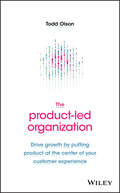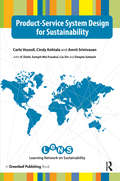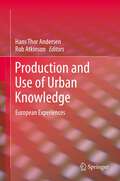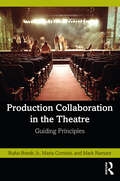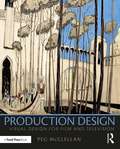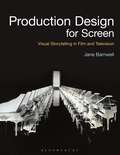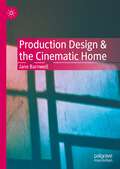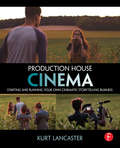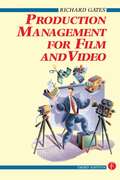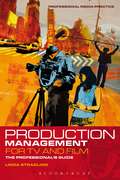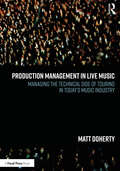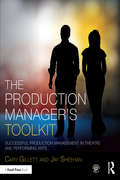- Table View
- List View
Product Development: An Engineer's Guide to Business Considerations, Real-World Product Testing, and Launch
by David V. TennantPRODUCT DEVELOPMENT An insightful development roadmap to help engineers and businesspeople successfully bring a product to market In Product Development: An Engineer’s Guide to Business Considerations, Real-World Product Testing, and Launch, accomplished project manager, engineer, and business strategist David V. Tennant delivers a comprehensive walkthrough of the full scope of product development activities, from initial business considerations to real-world product testing and launch. The book covers key product development considerations like determining the target market, working with a product development team, management challenges, funding, user identification, ergonomics, product design, testing, and launch. The distinguished author presents the material in the form of practical, hands-on tutorials with case studies featuring large corporations and small- and mid-size firms. He also includes team exercises and question-and-answer features to help early-career and aspiring engineers acquire the interdisciplinary and inter-department coordination skills they’ll require to successfully bring a new product to market. Readers will learn about the critical roles played by the engineering, marketing, and finance departments, as well as each stage of the product development process. The book also includes: Thorough introductions to product development and the role of the marketing group in product development, including corporate strategy, product and business plans, and marketing leadership Comprehensive explorations of the role of the engineering group in product development, including functional areas led by engineers and engineering leadership Practical discussions of the core team and teamwork in product development, including executives’ roles, the role of the accounting department, and the identification of key stakeholders In-depth examinations of how to move forward with product development after project approval Perfect for early- and mid-career engineers working in product-oriented companies, as well as marketers and other business professionals seeking to understand engineering best practices, Product Development is the ideal reference for use in upper-level undergraduate Product Development courses.
The Product-Led Organization: Drive Growth By Putting Product at the Center of Your Customer Experience
by Todd OlsonA playbook on product-led strategy for software product teams There's a common strategy used by the fastest growing and most successful businesses of our time. These companies are building their entire customer experience around their digital products, delivering software that is simple, intuitive and delightful, and that anticipates and exceeds the evolving needs of users. Product-led organizations make their products the vehicle for acquiring and retaining customers, driving growth, and influencing organizational priorities. They represent the future of business in a digital-first world. This book is meant to help you transform your company into a product-led organization, helping to drive growth for your business and advance your own career. It provides: A holistic view of the quantitative and qualitative insights teams need to make better decisions and shape better product experiences. A guide to setting goals for product success and measuring progress toward meeting them. A playbook for incorporating sales and marketing activities, service and support, as well as onboarding and education into the product Strategies for soliciting, organizing and prioritizing feedback from customers and other stakeholders; and how to use those inputs to create an effective product roadmap The Product-Led Organization: Drive Growth By Putting Product at the Center of Your Customer Experience was written by the co-founder and CEO of Pendo—a SaaS company and innovator in building software for digital product teams. The book reflects the author’s passion and dedication for sharing what it takes to build great products.
The Product-Led Organization: Drive Growth By Putting Product at the Center of Your Customer Experience
by Todd OlsonA playbook on product-led strategy for software product teams There's a common strategy used by the fastest growing and most successful businesses of our time. These companies are building their entire customer experience around their digital products, delivering software that is simple, intuitive and delightful, and that anticipates and exceeds the evolving needs of users. Product-led organizations make their products the vehicle for acquiring and retaining customers, driving growth, and influencing organizational priorities. They represent the future of business in a digital-first world. This book is meant to help you transform your company into a product-led organization, helping to drive growth for your business and advance your own career. It provides: A holistic view of the quantitative and qualitative insights teams need to make better decisions and shape better product experiences. A guide to setting goals for product success and measuring progress toward meeting them. A playbook for incorporating sales and marketing activities, service and support, as well as onboarding and education into the product Strategies for soliciting, organizing and prioritizing feedback from customers and other stakeholders; and how to use those inputs to create an effective product roadmap The Product-Led Organization: Drive Growth By Putting Product at the Center of Your Customer Experience was written by the co-founder and CEO of Pendo—a SaaS company and innovator in building software for digital product teams. The book reflects the author’s passion and dedication for sharing what it takes to build great products.
Product Lifecycle Management: PLM and Digital Twins (Decision Engineering)
by John StarkThis volume addresses the convergence of three technologies that emerged in the early 21st century: Product Lifecycle Management (PLM), the Internet of Things (IoT), and Digital Twins. These are available to all manufacturing companies as their products go through the product lifecycle. This starts with Ideation, continues through Definition, Realisation and Use/Support, and ends with Retirement/Disposal. This book is the 7th volume in a series that started in 2004 with the publication of ‘Product Lifecycle Management: 21st Century Paradigm for Product Realisation’, which has become a seminal book on PLM. The first chapters of the book address the fundamentals of PLM, the IoT and Digital Twins, highlighting their value and benefits. The following chapters look at applications and advantages resulting from the convergence of the three technologies in specific phases of the product lifecycle. Digital Twin applications in these phases include decision support, design iteration acceleration, predictive analytics and maintenance, product and process documentation, product upgrades, product and manufacturing process simulation, quality assurance, remote monitoring and troubleshooting, remote sales, training, virtual prototyping, and virtual showrooms. The final chapter addresses the implementation of an integrated PLM and Digital Twin environment. The book gives the reader a broad understanding, valuable insights, and practical guidance about three important technologies and the way they are converging and evolving together. It will stimulate innovation, propel companies forward, and motivate them to succeed in an increasingly digitally connected product world.
Product-Service System Design for Sustainability
by Carlo Vezzoli Cindy Kohtala Amrit Srinivasan Liu Xin Moi Fusakul Deepta Sateesh J.C. DiehlThis book, based on a huge European and Asian research project, is a state-of-the-art examination of the theory and practice of system innovation through Product-Service System (PSS) design for sustainability from a trans-cultural viewpoint. PSS design incorporates innovative strategies that shift businesses away from simply designing and selling physical products to developing integrated systems of products and services that satisfy human needs. The book provides background, advice and tools for designers interested in sustainable PSSs and has a wealth of case studies for practitioners to digest.
Product-Service System Design for Sustainability: Chinese Edition
by Carlo Vezzoli Cindy Kohtala Amrit Srinivasan Liu Xin Moi Fusakul Deepta Sateesh J.C. DiehlThis book, based on a huge European and Asian research project, is a state-of-the-art examination of the theory and practice of system innovation through Product-Service System (PSS) design for sustainability from a trans-cultural viewpoint. PSS design incorporates innovative strategies that shift businesses away from simply designing and selling physical products to developing integrated systems of products and services that satisfy human needs. The book provides background, advice and tools for designers interested in sustainable PSSs and has a wealth of case studies for practitioners to digest.
Production and Use of Urban Knowledge: European Experiences
by Hans Thor Andersen and Rob AtkinsonThis book provides new insights on cities and the nature of urban development, and the role of knowledge management in urban growth. It considers how knowledge informs policies and supports decision making, and can assist in addressing the drivers of urban change. The way that knowledge is produced and used in urban development is analysed, with examples drawn from a range of European countries. This book illustrates how the development and implementation of policies for urban areas can draw on knowledge management, even as the knowledge economy itself stimulates the evolution of the city as a place of innovation and creativity. Whilst knowledge grows in importance, so do urban issues, particularly in economic and political contexts at both European and national levels. These essays explore growth in the range of knowledge available in urban contexts, the ways to generate new knowledge from a wide range of stakeholders, and how these can make an effective contribution to decision making processes in urban development. The attractiveness of cities and surrounding areas to knowledge based forms of industry and investment and the competitiveness and performance of cities are a matter of major concern for national governments. In a sense it has become too important to leave to city politicians, and it is a topic requiring sustained reflection. This book gives the reader a detailed understanding of the issues involved and prompts further reflections.
Production at the Leading Edge of Technology: Proceedings of the 12th Congress of the German Academic Association for Production Technology (WGP), University of Stuttgart, October 2022 (Lecture Notes in Production Engineering)
by Mathias Liewald Alexander Verl Thomas Bauernhansl Hans-Christian MöhringThe German Academic Association for Production Technology (WGP) annually invites researchers coming from its institutes and from industry to contribute peer reviewed papers in the field of production technology. This congress proceedings provides recent research results and findings on leading-edge manufacturing processes. Main aim of this scientific congress is to push forward existing borders in production and to provide novel solutions of "Production at the Leading Edge of Manufacturing Technology”. Different sessions were held on the topics• Recent Developments in Manufacturing Processes• Advancements in Production Planning• New Approaches in Machine Learning• Aspects of Resilience of Production Processes• Creating Digital Twins for Production
Production Collaboration in the Theatre: Guiding Principles
by Rufus Bonds Jr. Maria Cominis Mark RamontProduction Collaboration in the Theatre reveals the ingredients of proven successful collaborations in academic and professional theatre training, where respect, trust, and inclusivity are encouraged and roles are defined with a clear and unified vision. Garnering research from conversations with over 100 theatre professionals on Broadway and in regional and educational theatre, the authors provide multiple approaches to working together that are designed to help students and teachers of theatre discover and develop the collaborative tools that work best for them. Each chapter offers practical application with discussion prompts from real-life scenarios to practice and develop the critical problem-solving skills necessary for theatre artists to navigate common collaboration challenges. Compelling topical case studies and insightful interviews invite readers to explore the principles of collaboration and inspire them to build joyful, equitable, and collaborative relationships in academic and professional settings. Production Collaboration for the Theatre offers theatre faculty and students a practical approach to developing the interpersonal skills necessary for a lifetime career in collaboration in the theatre. An ideal resource for actors, directors, designers, and production teams, this book provides theatre artists in training with an opportunity to develop their collaborative style in a way that will guide and support the longevity of a successful career.
Production Collaboration in the Theatre: Guiding Principles
by Rufus Bonds Jr. Maria Cominis Mark RamontProduction Collaboration in the Theatre reveals the ingredients of proven successful collaborations in academic and professional theatre training, where respect, trust, and inclusivity are encouraged and roles are defined with a clear and unified vision. Garnering research from conversations with over 100 theatre professionals on Broadway and in regional and educational theatre, the authors provide multiple approaches to working together that are designed to help students and teachers of theatre discover and develop the collaborative tools that work best for them. Each chapter offers practical application with discussion prompts from real-life scenarios to practice and develop the critical problem-solving skills necessary for theatre artists to navigate common collaboration challenges. Compelling topical case studies and insightful interviews invite readers to explore the principles of collaboration and inspire them to build joyful, equitable, and collaborative relationships in academic and professional settings. Production Collaboration for the Theatre offers theatre faculty and students a practical approach to developing the interpersonal skills necessary for a lifetime career in collaboration in the theatre. An ideal resource for actors, directors, designers, and production teams, this book provides theatre artists in training with an opportunity to develop their collaborative style in a way that will guide and support the longevity of a successful career.
Production Design: Visual Design for Film and Television
by Peg McClellanProduction Design: Visual Design for Film and Television is a hands-on guide to the craft of Production Design and Art Direction. Author Peg McClellan gives an insider’s view of the experiences and challenges of working as a Production Designer in film and television. The book covers three major areas, starting with an overview and the basics of job responsibilities, the artistic approach and the background which every Production Designer needs to be familiar with, and progressing to the mechanics of the role with a day-to-day breakdown of the job itself. McClellan takes you through script analysis, team collaborations, the hierarchy of a production, hiring a team, the business elements, locations, studio facilities, handling change, and everything in between. With case studies, insights from successful Production Designers, and inspiration in the form of over 200 colour photos and illustrations from storyboards to sets, this is the ideal book for students seeking a career in production design, and professionals looking to further their design knowledge.
Production Design: Visual Design for Film and Television
by Peg McClellanProduction Design: Visual Design for Film and Television is a hands-on guide to the craft of Production Design and Art Direction. Author Peg McClellan gives an insider’s view of the experiences and challenges of working as a Production Designer in film and television. The book covers three major areas, starting with an overview and the basics of job responsibilities, the artistic approach and the background which every Production Designer needs to be familiar with, and progressing to the mechanics of the role with a day-to-day breakdown of the job itself. McClellan takes you through script analysis, team collaborations, the hierarchy of a production, hiring a team, the business elements, locations, studio facilities, handling change, and everything in between. With case studies, insights from successful Production Designers, and inspiration in the form of over 200 colour photos and illustrations from storyboards to sets, this is the ideal book for students seeking a career in production design, and professionals looking to further their design knowledge.
Production Design for Screen: Visual Storytelling in Film and Television (Required Reading Range)
by Jane BarnwellPacked with colour film stills, exclusive pre-production artwork and behind-the-scenes production images, this landmark book celebrates the production designer's contribution to visual storytelling on screen. It illuminates the visual concepts behind familiar screen spaces and unpicks how and why they are so effective in conveying character and story.Seven case studies, developed from exclusive interviews with world-renowned designers, reveal the concepts behind some of the most engaging imagery on screen and establish a dialogue around the shared language of visual storytelling. Jane Barnwell offers a new methodology for evaluating the designer's work on screen through five categories of analysis: space, interiors and exteriors, light, colour and set decorating. All of which combine to create the visual concept evident in the final screen image and together provide a model for the analysis of production design.Practical exercises and examples of real world projects walk you through the design process from breaking down the script and developing initial ideas to identifying a coherent conceptual vision. If you are a filmmaker, Production Design for Screen will inspire and guide you in your own work.
Production Design & the Cinematic Home
by Jane BarnwellThis book uses in-depth case studies to explore the significance of the design of the home on screen. The chapters draw widely upon the production designer’s professional perspective and particular creative point of view. The case studies employ a methodology Barnwell has pioneered for the analysis of production design called Visual Concept Analysis, which can be used as a key to decode the design of any given film. Through the nurturing warmth of the Browns’ home in Paddington, the ambiguous boundaries of secret service agent homes in Tinker Tailor Soldier Spy and the ‘singleton’ space occupied by Bridget Jones, Barnwell demonstrates that the domestic interior consistently plays a key role. Whether used as a transition space, an ideal, a catalyst for change or a place to return to, these case studies examine the pivotal nature of the home in storytelling and the production designers’ significance in its creation. The book benefits from interviews with production designers and artwork that provides insight on the creative process.
Production for Print (Portfolio Skills)
by Mark GatterThis book gives designers the confidence to do everything necessary to ensure trouble-free, high-quality printing – to calibrate images (colour and black and white); adjust trapping levels in all the major software applications, and mix colours that won't print as something that is a complete surprise. It explains scanning and resolution, and discusses good and bad image formats, describing techniques to make images look good in print – even if they have been downloaded from the internet. There is advice on how to get accurate quotes from a printer, a checklist to use when sending a job to print and a glossary of print production terms. Changes to new edition:* Text fully updated to take account of new developments in print technology and software * 22,000 words of new/replacement text * Completely redesigned in Portfolio Skills series, with new cover * Many new colour illustrations added to make book more visual * All screen grabs now translatable
Production House Cinema: Starting and Running Your Own Cinematic Storytelling Business
by Kurt LancasterIn Production House Cinema: Starting and Running Your Own Cinematic Storytelling Business, renowned video storyteller Kurt Lancaster offers both students and professionals a practical guide to starting their own video production company and creating cinematic, client-based video content. Utilizing practical know-how along with in-depth analysis and interviews with successful independent production houses like Stillmotion and Zandrak, Lancaster follows the logistics and inspiration of creating production house cinema from the initial client pitch all the way through financing and distribution. The book includes: An examination of the cinematic and narrative style and how to create it; A discussion of the legal procedures and documents necessary for starting and operating a production house; Advice on crafting a portfolio, reel, and website that both demonstrates your unique style and vision and attracts clients; A guide to the financial business of running an independent production house, including invoicing, accounting, and taxes—and how much you should charge clients; Tips for how to better communicate with clients, and how to develop and shape a client’s story; A breakdown of how to select the right gear and equipment for a shoot, on budget; Cinematic case studies that offer detailed coverage of several short films made for clients.
Production House Cinema: Starting and Running Your Own Cinematic Storytelling Business
by Kurt LancasterIn Production House Cinema: Starting and Running Your Own Cinematic Storytelling Business, renowned video storyteller Kurt Lancaster offers both students and professionals a practical guide to starting their own video production company and creating cinematic, client-based video content. Utilizing practical know-how along with in-depth analysis and interviews with successful independent production houses like Stillmotion and Zandrak, Lancaster follows the logistics and inspiration of creating production house cinema from the initial client pitch all the way through financing and distribution. The book includes: An examination of the cinematic and narrative style and how to create it; A discussion of the legal procedures and documents necessary for starting and operating a production house; Advice on crafting a portfolio, reel, and website that both demonstrates your unique style and vision and attracts clients; A guide to the financial business of running an independent production house, including invoicing, accounting, and taxes—and how much you should charge clients; Tips for how to better communicate with clients, and how to develop and shape a client’s story; A breakdown of how to select the right gear and equipment for a shoot, on budget; Cinematic case studies that offer detailed coverage of several short films made for clients.
Production Management for Film and Video
by Richard GatesPacked with step by step information, hints and tips, this book provides all the basic information needed to production manage a film or video from beginning to end - from idea to delivery. Production Management for Film and Video gives all the basic information needed to production manage a film or video from beginning to end - from idea to delivery.Aspiring young film producers, programme makers and students of film or video production will find this an essential source of information, as indeed will anybody wishing to improve their knowledge and skills in the field. One is guided from the script or proposal, right through the various stages of production management to include:· script breakdown· crossplotting· scheduling· budgeting· preparation· the shoot· editing and post-production· deliveryNow in its third edition, Production Management for Film and Video has been further revised to include: · information on health and safety requirements· the need to be aware of computer generated imagery · the effect this kind of programme making has on schedules and budgets. Different kinds of management for different productions are also covered - from features through to documentaries - and advice is offered on how to run a production more effectively. Examples, taken from actual productions, demonstrate the kind of documentation needed to develop, run and control a production. Emphasis is placed on the basic principles of good management that apply to all the different kinds of film that can be produced.Richard Gates is a freelance producer/production manager and has been involved in over 40 productions of different kinds. He also lectures extensively on production and production management techniques.
Production Management for Film and Video
by Richard GatesPacked with step by step information, hints and tips, this book provides all the basic information needed to production manage a film or video from beginning to end - from idea to delivery. Production Management for Film and Video gives all the basic information needed to production manage a film or video from beginning to end - from idea to delivery.Aspiring young film producers, programme makers and students of film or video production will find this an essential source of information, as indeed will anybody wishing to improve their knowledge and skills in the field. One is guided from the script or proposal, right through the various stages of production management to include:· script breakdown· crossplotting· scheduling· budgeting· preparation· the shoot· editing and post-production· deliveryNow in its third edition, Production Management for Film and Video has been further revised to include: · information on health and safety requirements· the need to be aware of computer generated imagery · the effect this kind of programme making has on schedules and budgets. Different kinds of management for different productions are also covered - from features through to documentaries - and advice is offered on how to run a production more effectively. Examples, taken from actual productions, demonstrate the kind of documentation needed to develop, run and control a production. Emphasis is placed on the basic principles of good management that apply to all the different kinds of film that can be produced.Richard Gates is a freelance producer/production manager and has been involved in over 40 productions of different kinds. He also lectures extensively on production and production management techniques.
Production Management for TV and Film: The professional's guide (Professional Media Practice)
by Linda Stradling"What Linda Stradling doesn't know about production management isn't worth knowing" The Documentary Filmmakers GroupPlaying a key role in helping producers to interpret and realise the directors' vision, production managers are responsible for all organisational aspects of TV and film production - from start to finish. Now this essential handbook tells you how it's done. Written by highly experienced production manager and specialist tutor, Linda Stradling, this is a complete guide to the profession. It includes details on self-organisation and the best systems to use, budgets, schedules and cost control, hiring and firing, contracts, insurance, setting up a shoot, dealing with contributors, acquiring copyright, people skills and ethics. So whether you're just starting out or want to improve your knowledge and skills, this is the book for you.
Production Management for TV and Film: The professional's guide (Professional Media Practice)
by Linda Stradling"What Linda Stradling doesn't know about production management isn't worth knowing" The Documentary Filmmakers GroupProduction Managers are responsible for all the organisational aspects of a TV or film production such as scheduling and budgeting and assisting producers to interpret and realise the directors' vision. Linda Stradling is a highly experienced production manager and trainer. Her book is based on her training handouts and notes and offers a complete `manual' to the role including: self organisation and systems to use, budgets, schedules and cost control, cash flow, hiring and firing, contracts, insurance, health and safety, setting up an efficient and cost-effective shoot, dealing with contributors, acquiring copyright, sourcing CGI, editors, music cue sheets, deliverables, people skills and ethics. A chapter contribution is included from leading drama production manager Julie Clark (currently line producer on Glorious 39, Stephen Poliakoff's new film). Written by an industry insider, this is an exhaustive manual to every aspect of the job, with reference material and real-life examples. Essential paperwork and sample budgets can also be found on our website. A complete on-the-job reference tool.
Production Management in Live Music: Managing the Technical Side of Touring in Today’s Music Industry
by Matt DohertyProduction Management in Live Music: Managing the Technical Side of Touring in Today’s Music Industry is a handbook for the aspiring production manager looking to forge a career in the live music industry. This book outlines the role that a production manager performs and their key responsibilities, and takes the reader step by step through the entire process of preparing a show for a tour. From dealing with artists and management to hiring crew, from booking vendors and scheduling the day-to-day of a busy tour, this text covers everything that is needed to take the show into rehearsals and finally on the road. Every aspect of the job is covered, including the very important challenges that face today’s industry in the realms of sustainability, inclusion, diversity and mental health. Whether the show be on a festival, in a small theatre or club, or in a modern arena, this book clearly lays out the tasks and challenges and offers practical solutions to ensure the smooth running of a live performance. Production Management in Live Music is written for students in stage and production management courses and emerging professionals working in live music touring.
Production Management in Live Music: Managing the Technical Side of Touring in Today’s Music Industry
by Matt DohertyProduction Management in Live Music: Managing the Technical Side of Touring in Today’s Music Industry is a handbook for the aspiring production manager looking to forge a career in the live music industry. This book outlines the role that a production manager performs and their key responsibilities, and takes the reader step by step through the entire process of preparing a show for a tour. From dealing with artists and management to hiring crew, from booking vendors and scheduling the day-to-day of a busy tour, this text covers everything that is needed to take the show into rehearsals and finally on the road. Every aspect of the job is covered, including the very important challenges that face today’s industry in the realms of sustainability, inclusion, diversity and mental health. Whether the show be on a festival, in a small theatre or club, or in a modern arena, this book clearly lays out the tasks and challenges and offers practical solutions to ensure the smooth running of a live performance. Production Management in Live Music is written for students in stage and production management courses and emerging professionals working in live music touring.
The Production Manager's Toolkit: Successful Production Management in Theatre and Performing Arts (The Focal Press Toolkit Series)
by Cary Gillett Jay Sheehan"Our theater world is so much better with this book in it, and even better with Cary and Jay at the helm." –David Stewart, Director of Production for the Guthrie Theater The Production Manager’s Toolkit is a comprehensive introduction to a career in theatrical and special event production for new and aspiring professionals, given by expert voices in the field. The book discusses management techniques, communication skills, and relationship building tactics to create effective and successful production managers. With a focus on management theory, advice from top production managers provide insights into budgeting, scheduling, meetings, hiring, maintaining safety, and more. Through interviews and case studies, the history and techniques of production management are explored throughout a variety of entertainment venues: theatre, dance, opera, and special events. The book includes references, tools, templates, and checklists; and a companion website contains downloadable paperwork and links to other useful resources such as unions, venues, and vendors.
The Production Manager's Toolkit: Successful Production Management in Theatre and Performing Arts (The Focal Press Toolkit Series)
by Cary Gillett Jay Sheehan"Our theater world is so much better with this book in it, and even better with Cary and Jay at the helm." –David Stewart, Director of Production for the Guthrie Theater The Production Manager’s Toolkit is a comprehensive introduction to a career in theatrical and special event production for new and aspiring professionals, given by expert voices in the field. The book discusses management techniques, communication skills, and relationship building tactics to create effective and successful production managers. With a focus on management theory, advice from top production managers provide insights into budgeting, scheduling, meetings, hiring, maintaining safety, and more. Through interviews and case studies, the history and techniques of production management are explored throughout a variety of entertainment venues: theatre, dance, opera, and special events. The book includes references, tools, templates, and checklists; and a companion website contains downloadable paperwork and links to other useful resources such as unions, venues, and vendors.

